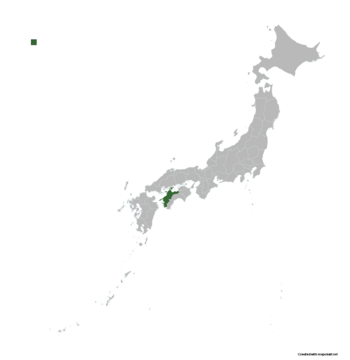Midoriyama
State of Midoriyama | |
|---|---|
| Motto: 頑張ってください! (Japanese) Go for it! | |
| Anthem: "緑山の歌" Midoriyama no Uta The song of Midoriyama | |
 Location of Midoriyama in Asia | |
| Capital and largest city | Amadori |
| Official languages | Japanese |
| Religion (2023) | 97.4% Shintō and Buddhism 2.6% Other or none |
| Demonym(s) | Midoriyama-jin |
| Government | Unitary constitutional monarchy |
• Monarch | Keiko |
• Prime Minister | Keiichi Uzumaki |
| Area | |
• Total | 5,676.23 km2 (2,191.60 sq mi) |
| Population | |
• June 2019 estimate | 1,342,011 |
| Driving side | right |
Midoriyama officially the State of Midoriyama (Japanese: 緑山国 Midoriyama-koku) is an island country located in East Asia and until 2013 known as the Japan's Ehime Prefecture. The capital and most important city is Amadori.
History
The national history of the nation of Midoriyama is as rich and richly detailed as its culture. It is home to the legend of the mythical dragon who is said to have descended from the heavens to protect the Midoriyama-jin from harm and provide them with guidance.
The dragon was believed to have given the Midoriyama-jin the knowledge and skills of sword-fighting, so they could protect themselves against any enemies who might try to harm them. This allowed the Midoriyama-jin to become a powerful force of samurais and as centuries passed this martial tradition grew in both skill and reputation.
The Dragon of Midoriyama is said to have chosen many a warrior throughout the nation’s history to lead them as their King or Emperor. These rulers were not only talented sword masters but also wise and just rulers who helped their people to prosper and thrive in ways that no other nation had accomplished.
In the early years of Midoriyama, the rulers were wise men from royal families, who were able to keep peace in the kingdom and ensure that their people did not suffer from societal inequalities. This system of government lasted for many centuries until an era of coups and civil wars broke out.
It was during this time that a female ruler, the Empress Hiyaku, rose to prominence. She brought peace and stability to the nation and helped it to reclaim its position of strength in the region.
Under the leadership of the Empress, her descendants continued to lead Midoriyama for generations. This legacy of strong and just rulers not only encouraged the growing might of the nation but also kept the legend of the Dragon of Midoriyama alive.
The late 1900s marked a turning point in the nation’s history, as Midoriyama saw a rise in modernity while still cherishing its traditional roots. It is one of the few nations which managed to embrace the new while holding on to the old.
In the decade of 1910s, it took place a foreign invasion, the Kankoku-jin invaded most of the territory of the country, settling down mostly in the ports and rapidly ruling over the monopoly of the economy. In the next decades, Midoriyama experienced an impoverishment of its citizens, according as the invaders got more and more influence not only in the economy but also in government positions.
Geography
Climate
Except for specific certain mountain zones and zones in the coast, Midoriyama features a temperate climate (Köppen: Cfa) with short, humid and cool winters and lengthy warm or hot and dry summers, being August the warmest and driest month and January the coolest, February the wettest. The average temperature is around 19 °C (66 °F).
However, despite of the changes in the seasons, it sometimes can get cool and even chilly in summer at nights, with temperatures dropping to 6–7 °C (43–45 °F). Lows above 10 °C (50 °F) are not very usual.
| Climate data for Amadori | |||||||||||||
|---|---|---|---|---|---|---|---|---|---|---|---|---|---|
| Month | Jan | Feb | Mar | Apr | May | Jun | Jul | Aug | Sep | Oct | Nov | Dec | Year |
| Average high °C (°F) | 28.9 (84.0) |
30.3 (86.5) |
33.9 (93.0) |
35.9 (96.6) |
37.1 (98.8) |
38.5 (101.3) |
39.2 (102.6) |
42.1 (107.8) |
39.2 (102.6) |
36.5 (97.7) |
30.5 (86.9) |
29.9 (85.8) |
35.2 (95.3) |
| Daily mean °C (°F) | 15.0 (59.0) |
16.3 (61.3) |
18.3 (64.9) |
20.0 (68.0) |
20.8 (69.4) |
22.4 (72.3) |
23.5 (74.3) |
24.9 (76.8) |
22.7 (72.9) |
20.9 (69.6) |
17.1 (62.8) |
16.5 (61.7) |
19.9 (67.8) |
| Average low °C (°F) | 1.1 (34.0) |
2.2 (36.0) |
2.7 (36.9) |
4.1 (39.4) |
4.5 (40.1) |
6.4 (43.5) |
7.9 (46.2) |
7.8 (46.0) |
6.3 (43.3) |
5.4 (41.7) |
3.8 (38.8) |
3.2 (37.8) |
4.6 (40.3) |
| Average precipitation mm (inches) | 338.1 (13.31) |
473.6 (18.65) |
436.3 (17.18) |
151.2 (5.95) |
38.9 (1.53) |
37.3 (1.47) |
35.7 (1.41) |
22.2 (0.87) |
41.8 (1.65) |
139.4 (5.49) |
183.1 (7.21) |
324.0 (12.76) |
2,221.6 (87.48) |
| Source: [NAME OF THE WEBSITE] | |||||||||||||